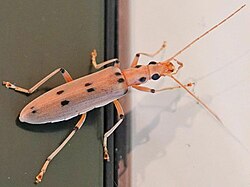Biology:Parisopalpus nigronotatus
| Parisopalpus nigronotatus | |
|---|---|

| |
| Introduced Parisopalpus nigronotatus seen in West Auckland, New Zealand | |
| Scientific classification | |
| Domain: | Eukaryota |
| Kingdom: | Animalia |
| Phylum: | Arthropoda |
| Class: | Insecta |
| Order: | Coleoptera |
| Infraorder: | Cucujiformia |
| Family: | Oedemeridae |
| Genus: | Parisopalpus |
| Species: | P. nigronotatus
|
| Binomial name | |
| Parisopalpus nigronotatus Boheman, 1858
| |
| Synonyms | |
| |
Parisopalpus nigronotatus, known by its common name, the spotted lax beetle, is a species of false blister beetles. It was first identified by Carl Henrik Boheman in 1858, under the name Nacerdes nigronotata.[1] Native to eastern Australia , the species was introduced to New Zealand in 1931.
Description
Parisopalpus nigronotatus is generally coloured brick-red, with dark spots found on the beetle's body and legs. The species is densely covered with pale hair. The beetle is typically between 8.7 and 12.2 mm in length.[2]
Parisopalpus nigronotatus can be told apart from other species of Parisopalpus by the presence of at least two dark spots on the beetle's body.[2]
Distribution
Parisopalpus nigronotatus is found in eastern Australia, south-eastern Australia and Tasmania.[3] It was introduced to New Zealand in 1931,[4] and is found in Nelson and the North Island.[2]
The species has been intercepted by biosecurity in Chile .[5]
Behaviour
The beetles lay their eggs in mangroves.[4] Grubs of the species are typically found in rotting wood, and as adults the beetles feed on nectar and pollen, and are attracted to light.[6]
The beetles secrete a toxic substance as a defense, which causes skin blisters in humans if touched.[4][6]
References
- ↑ Boheman, C.H. (1858). Kongliga Svenska Fregatten Eugenies resa omkring Jorden aren 1851-53. II. Stockholm: Norstedt. https://www.biodiversitylibrary.org/page/2473783.
- ↑ 2.0 2.1 2.2 Hudson, Logan P (1975). "A systematic revision of the New Zealand Oedemeridae (Coleoptera, Insecta)". Journal of the Royal Society of New Zealand 5 (3): 227–274. doi:10.1080/03036758.1975.10421850. ISSN 0303-6758.
- ↑ "Parisopalpus nigronotatus ( Boheman , 1858)". https://bie.ala.org.au/species/NZOR-6-75948.
- ↑ 4.0 4.1 4.2 Baird, Alex (17 January 2017). "The 'blister beetle' parents should watch out for". https://www.newshub.co.nz/home/new-zealand/2018/01/the-blister-beetle-parents-should-watch-out-for.html.
- ↑ Švihila, V; Fischer, FR (2012). "Parisopalpus defoei sp. nov. from Robinson Crusoe Island, Chile, the first known species of the genus from the Neotropical Region (Coleoptera: Oedemeridae)". Zootaxa 3394 (1): 31–34. doi:10.11646/ZOOTAXA.3394.1.3. ISSN 1175-5334.
- ↑ 6.0 6.1 "Spotted lax beetle". https://www.landcareresearch.co.nz/tools-and-resources/identification/what-is-this-bug/lax-beetle-blisters-2/.
Wikidata ☰ Q21316313 entry
 |

